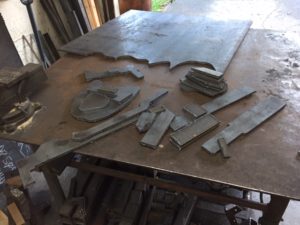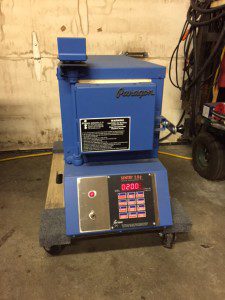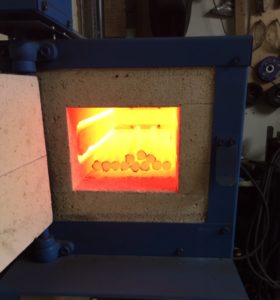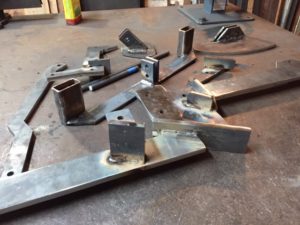 Hardened Plate
Hardened Plate
These days I have made the switch to using hardened plate to build my targets. Mainly because it creates a super tough target. And it is absolutely essential when building rifle targets. The material I primarily use is AR500 but there is also mild steel in non impact areas of the target. I also use some tool steel parts.
Hardened plate is steel that has been manufactured from an alloy that can be hardened. Something that cannot be done with mild steel… While hardened steel alloys are made to ASTM specs, hardness rating designations are not well regulated so the alloy is usually named then a number is added to designate the hardness rating. And this is usually a number from the Brinnell scale. AR 500 being the most familiar to shooters.
AR 500 is a hardened steel but it is not “armor plate”, it is hardened to a level that is more than adequate for target material. It is also the most well known product used for targets.
And you might find it surprising but AR 500 was not developed for the target industry. Rather is was developed for the mining and construction industry as an abrasion and impact resistant steel. That is what the AR really stands for, abrasion resistance… But it just so happens that it is a great material for targets. Especially rifle targets

And there are other products out there that are manufactured to the same standards as the well known AR500, one of which, Faralloy 500, I used to build my first batch of rifle targets.
Cost Comparison
Hardened steel is only about 20% more expensive than mild steel. I found that surprising considering what most target companies want for very simple targets made of hardened steel.
But there are important differences when working with hardened plate.
Working with Hardened Steel
The big issue for me when working hardened steel is that it requires some special considerations.
Yes it can be welded. Thicker pieces need to be pre heated and treated with some care as it cools so the welds don’t crack. You also need to use special rod when welding it. I have found that I do not have to pre heat it with the thinner sections I am usually working with but it should not be welded if the steel is really cold. A light pre heat has proven to be very effective when I just can’t stop working in colder temps
 A plasma arc torch is also very efficient at cutting hardened plate. Which is what I recently purchased. Fortunately the heat affected zone is very small when cutting hardened plate with plasma so there is very little impact on the hardness. Generally just a narrow area along cut edges, unlike an oxygen gas cutting rig which destroys the hardening of steel since it puts so much heat into the plate.
A plasma arc torch is also very efficient at cutting hardened plate. Which is what I recently purchased. Fortunately the heat affected zone is very small when cutting hardened plate with plasma so there is very little impact on the hardness. Generally just a narrow area along cut edges, unlike an oxygen gas cutting rig which destroys the hardening of steel since it puts so much heat into the plate.

Heat Treating
I also do some of my own heat treating on some of the components of the rifle capable targets. Found this is the best way to get the characteristics of the steel that best fit the function of the target.
 These days it is all done in a computer controlled heat treat kiln. This gives me far better control over the process and leads to a much stronger and more consistent product.
These days it is all done in a computer controlled heat treat kiln. This gives me far better control over the process and leads to a much stronger and more consistent product.
Fabrication
There is a lot of handwork in these targets. I also use a ton of jigs, well maybe not a ton but I have several hundred pounds of jigs built!
Some of my jigs are complex and others are super simple, but everyone of them just makes things easier, faster and more consistent to build.
